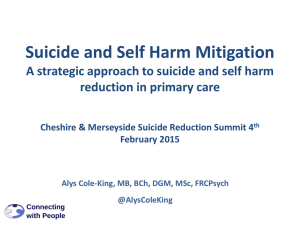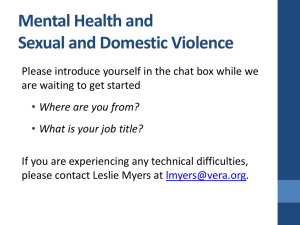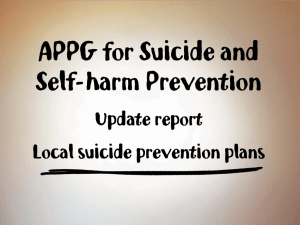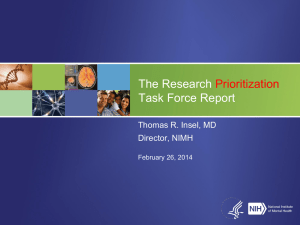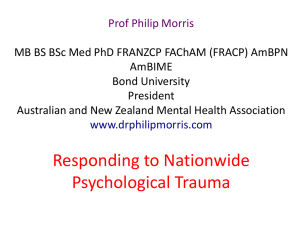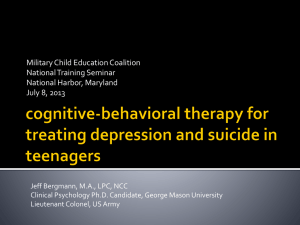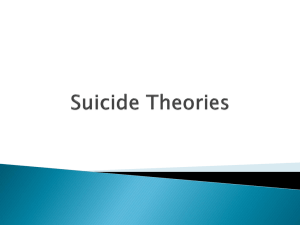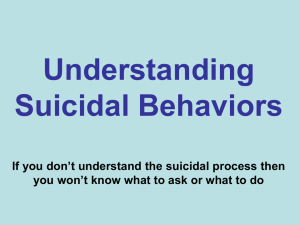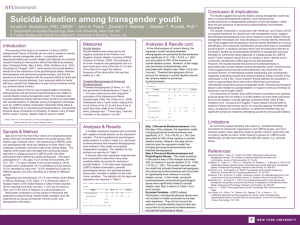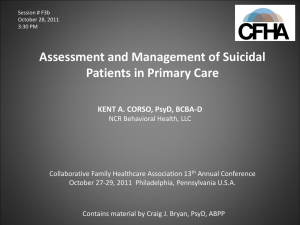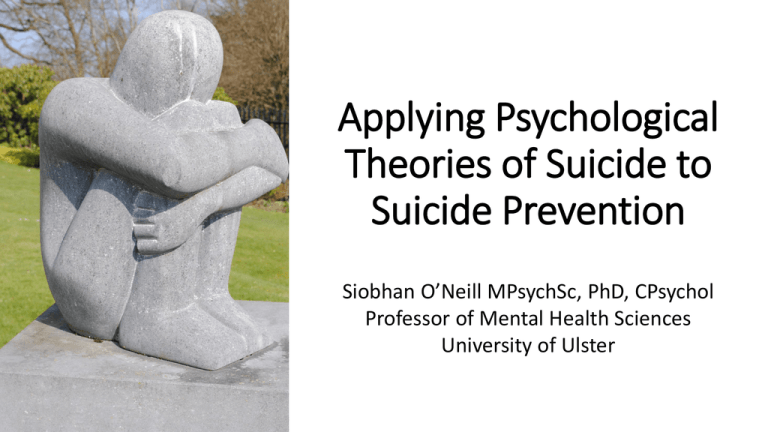
Applying Psychological
Theories of Suicide to
Suicide Prevention
Siobhan O’Neill MPsychSc, PhD, CPsychol
Professor of Mental Health Sciences
University of Ulster
Plan of Presentation
• Theories of suicide.
• Characteristics of deaths by suicide in NI.
• Suicidal behaviour in NI (ideation, plans and
attempts).
• Mapping theories to prevention.
Durkheim’s Theory (1897/1951)
Degrees of imbalance of social integration and moral regulation.
Egoistic. Result of a weakening of the bonds that normally integrate
individuals into the collectivity: in other words a breakdown of social
integration.
Altruistic. Occurs in societies with high integration, where individual
needs are seen as less important than the society's needs as a whole.
Anomic: Considered the product of moral deregulation and a lack of
definition of legitimate aspirations through a restraining social ethic
(e.g. religion).
Fatalistic: person prefers to die than to carry on living within their
society.
Schneidman’s Theory of Suicide
• Suicide = solution to psychological pain (Psychache).
• Goal orientated behaviour with annihilation of
consciousness or pain as its outcome.
• Unmet psychological need describes the stressor leading
to the suicidal decision.
• Emotion of overwhelming hopelessness.
• Reduced cognitive state serves to desensitize the
individual and heighten ambivalence.
• Alternatives to suicide are constricted by current
perceptual state.
Schneidman’s ‘Psychache’ (1996)
• Unmet need, relative to perceived norms heightens risk of suicide,
determined by learned responses during early experience.
• Thwarted love: a frustrated need for comfort and alliance;
• Fractured control: loss or perceived lack of autonomy;
• Assaulted self-image: individual need for affiliation and avoidance of
shame;
• Ruptured key relationships: responses to interpersonal difficulties and
grief experienced by loss of a nurturing presence;
• Excessive anger, rage and hostility = a thwarted need for dominance.
Joiner’s interpersonal-psychological theory of
suicidal behaviour (2005)
• Thwarted belongingness,
• Perceived burdensomeness,
• Acquired capability for suicide.
Thwarted belongingness
• Feeling disconnected from others, reporting a sense of isolation .
• Alternatively, while others might care, nobody can relate .
• Dysfunctional automatic thoughts: characteristic of mental illness and
skew the individuals' perceptions.
• Estrangement from others who have not experienced the same
overwhelming emotions, regardless of prior connection.
Perceived burdensomeness
• Distorted automatic thoughts, unable to contribute to society.
• They are not making any worthwhile contributions to the world
around them.
• Perceived liability: others' lives would be improved if they were to
disappear.
• Therapeutic interventions: Cognitive behavioral approaches such as
behaviour activation and cognitive restructuring can increase positive
experiences while diminishing the tendency to view the environment
through distorted lenses. Goal setting and attainment may increase
self-sufficiency.
Acquired capability for suicide
• In order to enact lethal self-harm, an individual must habituate to physical
pain and the fear of death.
• Person must become accustomed to pain and fear. Habituation, occurs
through repeated exposure.
• Physical pain becomes less pronounced over time when our body becomes
accustomed to the experience.
• Those who frequently self-harm experience pain analgesia - the absence of
pain - during self-injury episodes.
• Repeated attempts contribute to acquired capability.
• Experiences that involve witnessing pain and violence, even in the absence
of physical pain, can contribute to the acquired capability.
Integrated Motivational-Volitional Model
(O’Connor, 2011)
Integrated Motivational-Volitional Model
(O’Connor, 2011)
Integrated Motivational-Volitional Model
(O’Connor, 2011)
Integrated Motivational-Volitional Model
(O’Connor, 2011)
Integrated Motivational-Volitional Model
(O’Connor, 2011)
NI Suicide study
Characteristics of the deceased 2005-2011 (N=1667)
•
•
•
•
•
•
•
•
•
Funded by Public Health Agency R & D Division.
Ethical approval, confidentiality agreement
Researcher based in coroner’s office.
Suicides and undetermined deaths (algorithm probable suicides).
Coronial data: witness statements, post mortem, medical files.
Coded by the researchers.
Anonymised data, binary codes on >40 categories of variables.
Iron key encryption.
X-Y coordinates for locations.
O’Neill, Corry, Murphy, Bunting (2014) Journal of Affective Disorders
Main Points
•
•
•
•
•
77% male.
Rates high from 20-60 years.
The highest proportion were single (39.1% women & 48.3% men).
Almost a third lived alone at time of death (31.4%).
22.8% lived in the parental home (including younger individuals and
those who returned to the family home in adulthood).
• More than a fifth lived with a spouse (21%).
• 35% were employed at time of death, compared to 50.3% who were
classified as unemployed or “other”.
Prior Adverse Events (61%)
Not known 39%
Employment issues 5.1%
Financial concerns 5.3%
Health fears 5.7%
Death/ grief 10.7%
Relationship probs 34%
0
5
10
15
20
25
30
35
40
45
Emotions
• Loneliness
• Isolation
• Entrapment
• Shame
• Guilt
• Failure
• Burdensomeness
“UNBEARABLE
PAIN”
Method of Suicide
• Hanging (60.5%)
• Drowning (7.9%)
• Overdose (18.7)
• Gassing (2.6%)
• Firearms (3.4%)
• Other (6.9%)
60.5%
18.7%
7.9%
Hanging
Drowning
6.9%
Overdose
2.6%
3.4%
Gassing
Firearms
Other
WORLD MENTAL HEALTH
The NI Study of Health and Stress
• Standardised interviews in > 40 countries with >100,000
•
•
•
•
•
participants worldwide.
Coordinated by Harvard and the World Health Organisation.
Computerised interview methods developed at the Survey
Research Centre University of Michigan (training certification).
Trained lay interviewers from RES & MORI.
Clustered random sample.
68% response rate, 4340 participants.
Funded by: NI Public Health Agency,
Research & Development Division
Suicidal Behaviour in Northern Ireland
NI Study of Health and Stress (World Mental Health Survey Initiative;
68% rr, n=4340).
• Ideation: Seriously considered suicide.
• Females: 10.6%, Males: 7%
• Made a plan for suicide.
• Females: 2.5%, Males: 2.4%
• Suicide attempt.
• Females: 4.3%, Males: 2.3%
O'Neill S, Ferry F, Murphy S, Corry C, et al. (2014) Patterns of Suicidal Ideation and Behavior in Northern Ireland and Associations
with Conflict Related Trauma. PLoS ONE 9(3): e91532. doi:10.1371/journal.pone.0091532
http://www.plosone.org/article/info:doi/10.1371/journal.pone.0091532
Trauma and Suicidal Behaviour in NI
Ideation
• Mental disorder
8.6
• Non-conflict trauma
1.8
• Conflict related trauma 2.3
Plan
• Mental disorder
15.8
• Non-conflict trauma N/S
• Conflict related trauma 2.2
Attempt
• Mental disorder
15.2
• Non-conflict trauma
2.6
• Conflict related trauma N/S
WHY?
• Conflict experience is protective.
OR
• Conflict associated with increased likelihood of death on first
attempt.
Look at theories of suicide: Joiner/ Klonsky/ O’Connor
Why do people die by suicide?
• Suicide is a goal directed behaviour to address
unbearable pain.
• Pain + Hopelessness thoughts of suicide (ideation).
• Connectedness prevents enaction.
• If pain > connectedness plan.
• Whether this leads to death is dependent upon capability
or access to means.
• If total capability > fear of attempting attempt.
The Northern Ireland Context
• Conflict increases connectedness.
• Post conflict: reduced connectedness (especially those
who have been most affected).
• Exposure to pain habituation (less fear/ more
expertise).
• Access to means.
• Cognitive access to means: Information.
Suicide prevention: The next steps
• Creating a culture of social integration and connectedness.
• Looking at emotional responses to life events.
• Evidence based treatments for mental disorders.
• Seeking help is a sign of strength.
• Considering acquired capability and access to means (including
cognitive access to means).
• Improving the validity of the data on suicide.
Thank You
• Dr Colette Corry
• Professor Brendan Bunting
• Dr Sharon Brady
• Dr Finola Ferry
• Dr Edel Ennis
• Dr Sam Murphy
• Danielle McFeeters
• Tony Benson
• Coroner Mr Lecky and his staff
@profsiobhanon
sm.oneill@ulster.ac.uk





